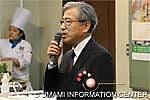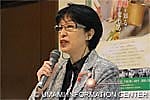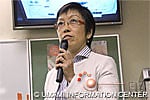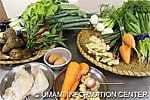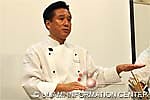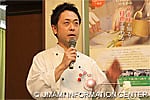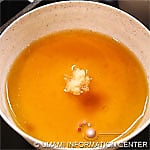2014 Umami Lecture in Tokyo "The power of 'UMAMI' connects the world" -Learning about umami will change your cooking!-
December 2014
The Umami Information Center(Nonprofit organization) held the "2014 Umami Lecture in Tokyo" at 1pm on October 19th (Sun), 2014 in collaboration with Hana Cooking College.(Taito-ku, Tokyo)
This lecture is the 4th collaborative event with cooking colleges, following Niigata, Fukuoka and Hamamatsu. The contents of the lectures are umami lectures by specialists and umami talks and demonstrations by experts of Japanese, Chinese, and French cuisine aiming to promote better understanding of umami for food specialists, such as cooks, chefs, nutritionists, cooking college faculty members, and cooking researchers.
Unlike the past three lectures, the food ingredients used in the umami rich recipes are selected from Edo vegetables and ingredients from Tokyo and its suburbs recommended by rising star chefs. In addition, the umami talk by a Japanese chef who does remarkable work and a specialist from the culinary science field joined in the program. The panel discussion entitled "Knowing umami, Transforming dishes" allowed participants to deepen their knowledge on umami.
Following the greetings by the hosts, including Chairman Takashi Yamamoto of the Umami Information Center and Chairman Chieko Sakamoto of the Hana Cooking College, Director Ninomiya of Umami Information Center gave the umami lecture.
In the umami lecture, director Ninomiya explained basic information on umami such as characteristics and function including umami tasting.
First, she mentioned that there are two ways to express umami in Japanese. One is 旨み(or 旨味.) This word has broader meaning to express sensory deliciousness. Another umami (うま味)is to express a certain taste substance which is scientifically stipulated. With its similar pronunciation, "umami" is often confused with "deliciousness" in Japan, though, "umami" is the taste imparted by a number of foods and one of the five basic tastes. One of the objectives of the lecture is to enable participants to understand what umami is correctly.
Next, she explained major umami substances; glutamate, inosinate and guanylate along with sweet substances (sucrose) and sour substances (acetic acid and citric acid) furthermore the discovery of umami.
Three characteristics of umami are its long lasting quality, tongue coating feel and mouth-watering sensation. Dr. Ninomiya explained about these three characteristics using cherry tomatoes. She also mentioned the synergistic effect of umami and how it accentuates other tastes. Using vegetable bouillon and comparing the bouillon with salt and bouillon with salt as well as an umami substance, participants experienced the effect of umami.
In the last part of her lecture, she explained the fact that umami is a universal taste and there are many traditional seasonings that utilize umami. She introduced main seasonings and food ingredients rich in umami.
Next, Mr. Yoshihiro Murata of Japanese food, Mr. Yuji Wakiya of Chinese food, and Mr. Hiroshi Yamaguchi presented "Umami Talk and Demonstration." The food ingredients used in the umami rich recipes were selected from Edo vegetables and ingredients from Tokyo and its suburbs recommended by rising star chefs.
Japanese cuisine came first. The demonstration was done by Mr. Yoshihiro Murata, the owner of "Kikunoi," The ingredients for his recipes were selected by Mr. Kimio Nonaga, 3rd Owner Chef of "Nihonbashi Yukari". His selections were Tokyo Shamo (gamecock), Kanamachi Kokabu (turnip) and Tokyo origin dried cherry tomatoes.
In the beginning, participants experienced the synergy effect of umami by using kombu dashi and dried bonito flakes. Participants drank half of the kombu dashi, which was distributed, and next they thoroughly chewed dried bonito flakes in the mouth. When they drank the remaining kombu dashi again afterward, they experienced much stronger umami than the kombu dashi they tasted at first. This is the synergy effect, which is one of umami's functions.
Next, he discussed dashi ingredients that he uses when he gives lectures overseas. He explained that he sometimes makes dashi by using food ingredients available in the country because kombu and dried bonito flakes may not always be available overseas when he makes the first dashi. Following this discussion, he introduced the "New Style Dashi" in the demonstration by using vegetables, such as dried tomatoes, dried morel mushrooms, and minced chicken breast, which was served for participants at the same time. Then he performed a cooking demonstration for white chawanmushi (steamed egg hotchpotch) with the new style dashi and Kanamachi turnip, egg white and soy milk, etc. as a tasting menu. The venue was filled with the participants' voices of surprise and admiration for Mr. Murata's new idea and cooking method.
Following Mr. Murata, Mr. Yuji Wakiya, Owner Chef of "Wakiya Ichiemi-charo," went up on the stage. Mr. Yoshifumi Ozawa, head chef of "Toulandot Garyukyo" chose Tokyo grown ingredients such as Edomae conger, Takinogawa burdock, dried shiitake mushrooms and Kogetsu Seriryumai rice for Chef Wakiya as ingredients for his recipes.
Chef Wakiya's lecture began with the cooking demonstration of stock, which is a Chinese representative dashi in Chinese food. He explained that adding kombu as one of the ingredients in addition to Jin hua huo tui, pork shin meat, and old chicken (ro-chi) and that umami was significantly enhanced with the synergy effect between the inosinate in the pork ribs and chicken and the glutamate in the Jinhua ham and kombu, enabling him to make tastier Jinhua shan tang soup stock. Furthermore, participants tasted it.
Next, he performed a cooking demonstration for two ways of cooking for Edomae conger eel; "Dried conger eel scented with szechuan pepper and baiju" and "Oil-grilled conger eel scented with szechuan pepper and orange peel." Using them, he showed how to make "Chinese rice porridge with umami of two kinds of conger eel." The venue was filled with the participants' voices of admiration for his cutting edge idea to use grown ingredients and technique.
The last demonstration on the stage was Mr. Hiroshi Yamaguchi, General Manager/Executive Chef of "Kobe Kitano Hotel." Though Mr. Shota Sasaki, head chef of "mikuni MARUNOUCHI" was unable to attend the lecture, he delivered his message and explained about his selection: Akikawa beef, Takinogawa burdock and mushrooms.
In the lecture, he allowed participants to experience their first-ever taste of slow-cooked Akikawa beef that provided a tender texture with umami. He realized a synergistic effect combining the slow-cooked beef and powdered mushroom originating from Tokyo. The venue was filled with high praise from the participants not only for his gorgeous and magical French cooking technique, but also for his cooking method based on scientific evidence.
Afterwards, everyone sampled Chef Murata's "White chawanmushi (steamed egg hotchpotch) -With new style dashi and Edo vegetable Kanamachi turnip-," Chef Wakiya's "Chinese rice porridge with umami of two kinds of conger eel." and Chef Yamaguchi's "Slow-cooked Akikawa beef and Tokyo mushroom poudre." After all participants sampled, the venue was filled with voices of admiration for the dishes extracted by umami.
In the following umami talk by Japanese chef, Ms. Saiko Izawa who is working actively in Sao Paulo, Brazil gave a lecture titled "South American chefs learning about and making good use of umami."
In her lecture, she explained that traditional Brazilian dishes use umami empirically, however Brazilian chefs have little knowledge on umami and have no opportunity to learn about it. Once they understand what umami is, they may create stunning dishes." She also introduced Faijoada, traditional Brazilian dish and various umami rich ingredients and talked about the future expectation of Brazilian cuisine.
Soon afterward, the panel discussion commenced with Dr. Ninomiya as MC, Messrs. Murata, Wakiya, Yamaguchi and Dr. Hidemi Sato, visiting professor of the Food science faculty in the Nippon Veterinary and Life Science University. First, Dr. Sato shared her impression and comments on the demonstration of the three chefs' using scientific data.
As for Mr. Murata's demonstration, she mentioned that he was very perceptive in recognizing the aroma of Japanese dishes as one that is universal. To express aroma without resistance, he used soy milk and created white chawanmushi.
As for Mr. Wakiya's, she was impressed with his professional technique of using oil as a cover for simmering conger eel. Since various umami ingredients were used, she had no idea how his dish would taste; however, she was very surprised to find the dish tasted unexpectedly refreshing. As for Chef Yamaguchi's presentation, she commented that "Mr. Yamaguchi disassembled umami in his dish and rebuilt it in order to realize his vision in the pursuit of creating delicious beef. She also mentioned that he expressed it by the synergistic effect of combining the flavors of umami-rich, tender beef and champignon."
Dr. Ninomiya asked each chef how they came to know umami and how their dish changed with their knowledge on umami. The three chefs talked about their experience and answered the questions from participants.
Finally, the Umami Lecture was completed with the closing speech by Toshihide Nishimura, vice chairman of the Umami Information Center, after introduction of the assistants who helped with the lecture and faculty members and students of Hana Cooking College.
On the day of the lecture, 125 people participated at the venue in Tokai Cooking and Confectionery College. Participants shared many positive evaluations with us, such as "We were able to gain good understanding of umami, which is common in Japanese dish, Chinese dish, and French dish," "We enjoyed the lecture about Brazilian cuisine which is hardly available in Japan." "We got similar impression with Dr. Sato's comment." " We enjoyed tasty food made by top chefs by utilizing umami," and "We would love for this to be held again," etc.
The Umami Information Center will continue to promote these activities in order to promote understanding and dissemination of umami. We thank you in advance for your continuous support.
